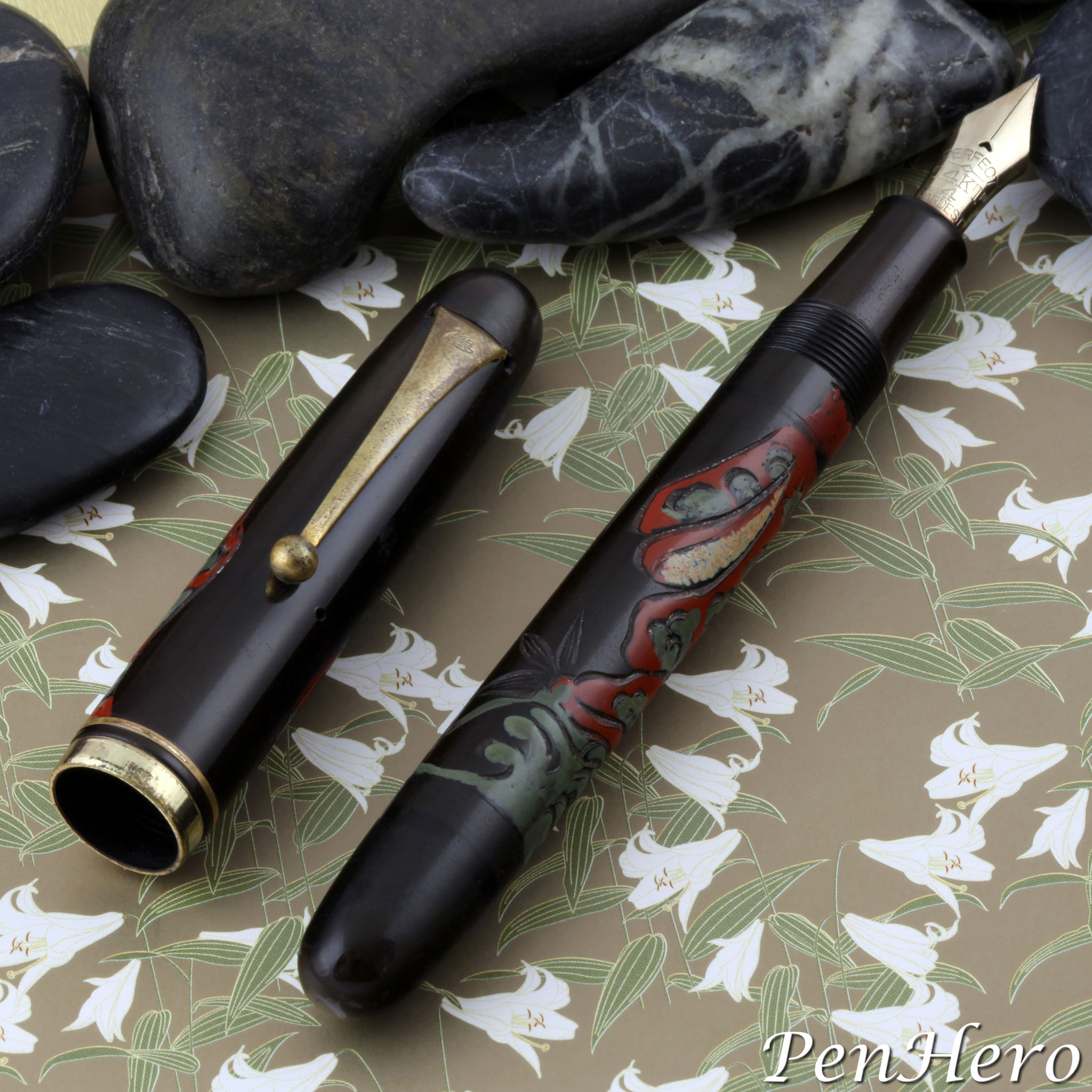Swan Japan Daruma Carved Fountain Pen c. 1930s
by Jim Mamoulides, September 22, 2023
 Swan Japan Daruma carved fountain pen c. 1930s
Swan Japan Daruma carved fountain pen c. 1930s
A Japanese Swan
This is a c. 1930s Swan Japan eyedropper fountain pen with a carved image of Daruma, the Indian monk Bodhidharma, who is believed to have brought Chan Buddhism to China in the 5th or 6th century and would later be exported to Japan as Zen Buddhism. The clip has the Swan Japan logo at the top and SWAN is carved in the barrel just below the image. The clip and trim are gold plated, though the plating is heavily worn off in many places. The owner's name, Iida, is carved on the barrel. The pen has a gold nib stamped PERFECT over 14K over 4 over HARDEST. The gold nib dates the pen to before the Second World War, probably c. 1935-1938.
 Swan Japan Daruma carved fountain pen c. 1930s
Swan Japan Daruma carved fountain pen c. 1930s
Who Was Swan Japan?
Swan Mannenhitsu Seisakusho, known as Swan Japan by collectors, was a Japanese company established by Nobuo Itô in 1900. According to Fountain Pens of Japan by Andreas Lambrou and Masamichi Sunami, the company initially resold stylographic pens made in Japan but as early as 1906 was importing nibs for their own Swan branded pens.
 Swan Japan Daruma carved fountain pen c. 1930s
Swan Japan Daruma carved fountain pen c. 1930s
Nobuo Itô’s Swan brand was registered in Japan before Mabie Todd & Company began to export pens to that country, but the company’s swan logo, trademark, and pen designs were so similar to Mabie Todd’s, as seen in the 1912 Swan Japan catalog, that they were sued by Mabie Todd for trademark infringement. Because Swan Japan was already an established and registered brand, Mabie Todd lost, leaving two Swan brands in Japan. The company also copied Parker design elements as also seen in the same 1912 Swan Japan catalog, showing pens featuring a “Lucky Curve” feed, including an image of the copied Parker design.
 Swan Japan Daruma carved fountain pen c. 1930s
Swan Japan Daruma carved fountain pen c. 1930s
Swan Japan was initially very successful, growing by 1918 to “140 people and (producing) around 200,000 pens a year,” and “(capturing) around 60 percent of the Japanese pen market.” Although other Japanese pen competitors arose, taking away most of Swan Japan's market share, the company continued manufacturing after the Second World War as a minor manufacturer in Japan.
 Swan Japan Daruma carved fountain pen c. 1930s
Swan Japan Daruma carved fountain pen c. 1930s
Daruma and Zen Buddhism
The Indian monk Bodhidharma is credited with bringing Chan Buddhism to China in the sixth century. Japanese Buddhist monk Dōgen introduced Chan Buddhism to Japan in the thirteenth century, known in Japan as Zen Buddhism and Bodhidharma became known there as Daruma. Daruma taught meditation to reach personal enlightenment, clearing the mind from worldly distractions. Among many legends about him is one where he spent nine years meditating by staring at a wall. Another has him upon his arrival in China spending time training monks of the Shaolin Monastery in the physical arts that became the martial art kung fu.
Daruma is often depicted in artworks with an intense expression, with large eyes, bushy eyebrows, a large nose, a brushy beard and sometimes a red hooded robe. Many artworks portraying him appear to be created quickly and light on detail, expressing his teaching that the path to enlightenment is achieved spontaneously through meditation and without texts.
 Swan Japan Daruma carved fountain pen c. 1930s
Swan Japan Daruma carved fountain pen c. 1930s
On this pen Daruma’s face is orange, and his robe is red with green floral decorations. His face is very defined, but the rest of the image, primarily his long robe, becomes more heavy lined and less detailed, almost a naïve style. The single full body portrait is deeply carved into the surface of the pen, down the length of the back of the cap and barrel, and then painted with colored urushi lacquer. It’s not known if this was an after purchase decoration and the artist is unknown.
 Swan Japan Daruma carved fountain pen c. 1930s
Swan Japan Daruma carved fountain pen c. 1930s
Daruma depicted on a twentieth century pen would likely be done as a token of good luck for the owner. As this was a special art pen, it was not inked, so there will not be a performance review and as it may be one of a kind, there will not be an identification guide. What began as a plain black Swan balance shaped eyedropper fountain pen was transformed into a good luck charm artwork. It shows a lot of use, and I would hope it provided years of good service and indeed luck for its owner. Another very unusual pen that would add to a fine Japanese pen collection.
References
Bodhidharma (Daruma), The Metropolitan Museum of Art
Daruma, Denver Art Museum
Fountain Pens of Japan by Andreas Lambrou and Masamichi Sunami, 2012 Andreas Lambrou Publishers Ltd. Epping, Essex, UK, pages 24, 171-177
Insight: The Path of Bodhidharma, University of Southern California Pacific Asia Museum
Portrait of Bodhidharma, The Metropolitan Museum of Art
Swan Japan, Crónicas Estilográficas, © Copyright 2010-2023 Bruno Taut
Zen Buddhism | Essay | Heilbrunn Timeline of Art History, The Metropolitan Museum of Art
Interact
Comments on this article may be sent to the author, Jim Mamoulides


